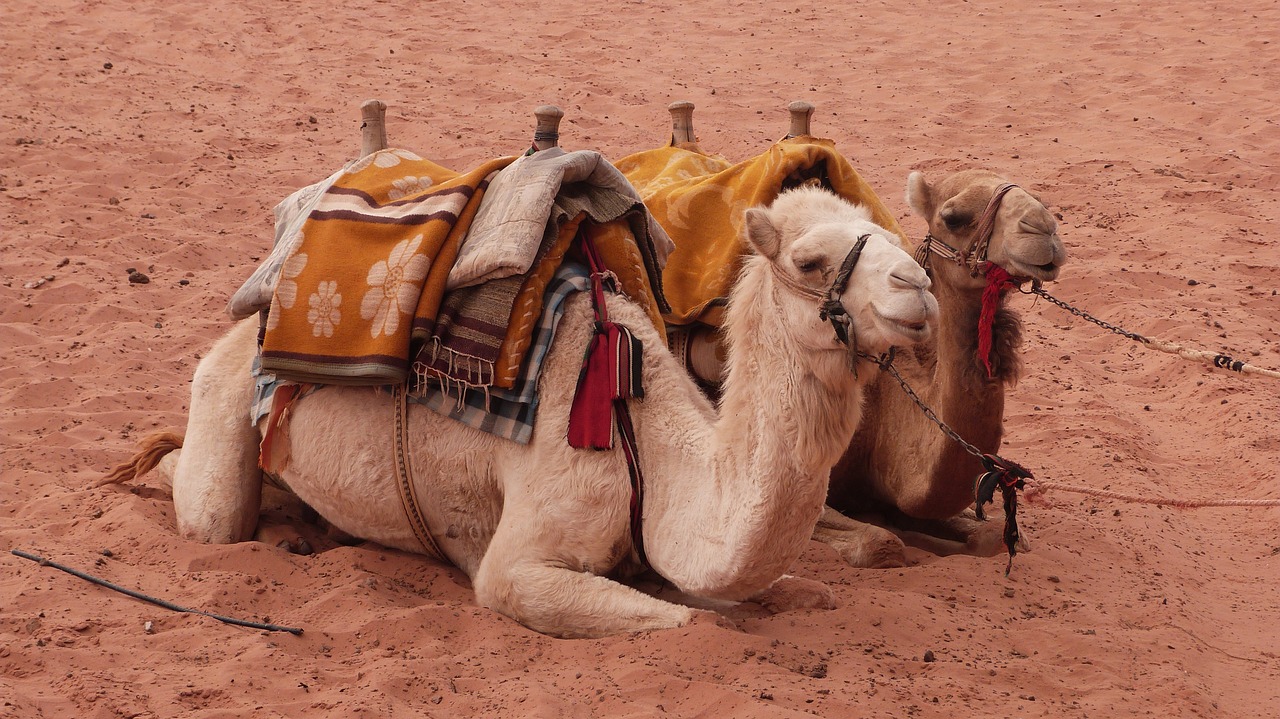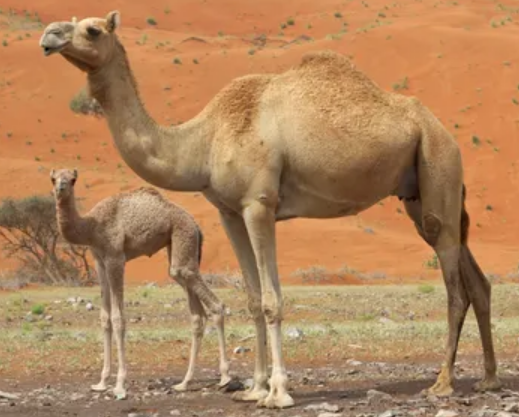Articles
Around The Camel
Behavior
Fairly placid animals: no aggressive reactions.
Dromedaries may want to be impressive in front of humans.
Strong, imposing animals: can carry up to 350 kg.
Main dangers: biting / hitting / jostling.
A male expresses reproductive male behavior at 7-8 years. Intimidation: swelling of the soft palate, vocalizations. He can be violent and brutal during the rut. Camels respect the dominant male.
Females in heat can be aggressive and dominant.
Males can play a moderating role in conflicts and intervene.
Separate animals according to their status (lactation, pregnancy, males, growing young, maternity).
Training
Training begins at an early age, with camels.
Be particularly careful with camels bottle-fed by humans: as adults, camels see humans as rivals and can be particularly aggressive.
Stroke and respect the camel, but avoid playing with it, so that it respects you in turn.
The right attitude
Be present in front of the animal: avoid running away, stay upright and face-on, raise your arm in the air to assert yourself.
Don’t crouch.
Be relaxed.
Use gentle movements.
Approach camels from the sides, never from the front.
Equipment required for handling
Halter.
Lead rope.
Muzzle for breeding males.
Some use a nose ring for breeding males.
Riding
Start training for breeding: from age 3.
Allow up to 3 years for training.
Animals must be groomed before mounting.
Feeding
The camel is a pseudo-ruminant, with 3 stomachs.
Intake capacity of around 1.9 kg per 100 kg live weight.
Eats very fibrous forage: high cellulolytic activity in the rumen.
Needs good quality protein for milk synthesis.
Low water requirements of around 80 ml/kg/d.
Very good pH buffering capacity in the stomach, making it less prone to metabolic disorders than other herbivores.
High absorption capacity for volatile fatty acids.
Low urinary excretion and high urea reuse efficiency: low nitrogen requirements.
No ketone bodies are produced during fat mobilization, so it cannot develop acetonemia.
Average weight
Animal Young 1 year 2 years 3 years 4 years Adult female Adult male
Live weight (kg) 70/80 140/160 230/250 430/450 550/600 700/750

Daily camel food
Forage
They can be very fibrous.
They may contain quality proteins, as in the case of alfalfa, for example.
Production nitrogen supplements
Supplements that are not too rich in nitrogen.
Mineral and vitamin supplements
Salt at will in lickable blocks or granules.
Camel’s Star. Vitamins. Trace elements. Other minerals depending on soil deficiencies: selenium.
Camel need in lactation
Basal diet: alfalfa hay, grass and straw (1-2 kg), sorghum, etc.
3 to 5 kg market concentrates (15-18% TP) or barley, depending on production level.
Two-step lactating camel ration
4 kg oat hay in the morning, 5 kg alfalfa hay in the afternoon.
In season, 8 kg of green alfalfa at 15-25% DM can be added.
100 g per day Camel’s Star.
Precautionary measure
Rapid fattening can lead to infertility.
Tendency to overfeed naturally.
High salt requirements: 20 g/100 kg body weight.
Risk of alkalosis (blood-breathing) and hyperuremia (blood acid) if ration rich in nitrogen.
Urea poisoning from molasses/urea blocks.
Fermented foods could deteriorate milk quality.
Wheat-type cereals favor acidosis if animals have low requirements.
Excessive water consumption may cause diarrhoea.
Breeding
Breeding begins between 3 and 6 years of age.
Mating season: November to April.
80% of cases: asymptomatic estrus.
Artificial insemination.
Ovulation provocation.
Embryo transfer possible.
Spawning
- 1 or 2 reproducers for 30 females (for safety, it is preferable to have 2).
- In rut: aggressive male, soft palate protruding from mouth and occipital glands secrete dark liquid.
- Duration of mating: 7 – 35 minutes, on average 15 minutes, up to 50 minutes.
- Natural spawning in pasture or stalls possible.
- Controlled mating: female isolated, forelegs (or even hindlegs) shackled, male led to female, operation repeated once a day for 2 to 3 days.
Gestation – whelping
Gestation period averages 12.5 months.
Always use gloves when handling runts.
Less than 5% dystocic grooming.
Twins extremely rare (<1%).
Diagnosis
Positive when the female raises her tail in the presence of the male (hand-walking with a man). 90% reliable.
Rectal palpation of the left uterine horn: from 6 to 8 weeks.
Ultrasound: from 20 days of gestation.
Progesterone: positive if 2 samples 15 days apart above 2ng/ml (blood test).
Anomalies
Early embryonic mortality (<3 months) often goes unnoticed: up to 10% of animals.
Abortion (<11 months): 2 to 20% depending on the farm. Infectious causes (brucellosis, rift fever).
Stillbirth: 3 to 10%.
Gestation
Fertility: 45.0%.
Fertility: 45%.
Duration 12.5 to 13 months.
Farrowing
Often takes place in the middle of the day, between 12 and 5 pm.
A few hours before, the pelvic ligament relaxes and the female isolates herself.
Less than 5% of dystocic groomings.
Twins are rare, less than 1%.
Camel rolls over in 25% of cases.
Chorioepithelial placenta expelled within one hour. Placenta retention rare.
Lactation
Lactation can last from 8-12 months to 16-18 months.
The level of lactation can be persistent: 16 months after calving, camels may still be at 20% of their production.
The lactation curve peaks after 3 – 4 months. With a plateau that can last 3 – 4 months.
A camel’s milk production increases with her lactation rank.
Seasonality is important: milk production is higher following a winter farrowing.
Drying
After a maximum of 9 to 10 months of lactation, camels should be gradually given less feed, in preparation for dry-off. Nitrogen-containing feeds are avoided, leaving only forage. This reduction takes place over one month and leads to a slight drop in camel productivity.
Breeding triggers dry-off.
Dry-off can be triggered if the camel rejects her heifel.
The camel will dry up on its own if it is not solicited.
If the camel is pregnant, it will dry up after about 3 months without human intervention.
Chamelon
Isolate mother and calf in a dedicated farrowing pen to facilitate handling.
Dry the camel and bring it to the udder to help it drink quickly. Few camels stand up on their own. If the mother refuses the colt, milk her and give the bottle to the colt.
Disinfect the navel with a solution such as tincture of iodine.
Chamelon must ingest 1 to 2 liters of colostrum within 12 hours of birth.
Freeze good-quality colostrum so you can have some on hand if needed.
Diarrhea is infrequent.
Body temperature is not a reliable indicator of health.
Colostrum
Colostrum must be drunk quickly to allow the transfer of immunity. The chamelon’s digestive tract gradually becomes impermeable to immunoglobulin G (IgG).
Measuring IgG concentration with a densimeter or reflexometer enables camels to be compared with each other. The minimum reference concentration seems not to be known yet.
Camels should ingest one to two liters of colostrum.
Milk and freeze good-quality colostrum in small-volume bags (50 cl). Reheat it in a bain-marie before bottle-feeding.
Milking
Camels females
Very low citernal milk reserve: good stimulation of the animal is required to trigger the milk ejection reflex in order to recover the alveolar milk.
Very strong maternal bond: need for the camel to be present during milking to ensure sufficient stimulation of the animal (especially at the start of lactation).
Progressive milking training is essential to ensure that the animals are not stressed and are willing to give milk. It requires mastery of manual milking.
Before milking
1) The camel suckles (about 30 seconds) to stimulate the milk ejection reflex.
2) Extraction of 1st milk jet, evaluation of appearance and detection of any problems.
3) Cleaning (warm water) and drying of teats with individual wipes.
Manual milking
After the preparation phase, you can : - Separate the camel from its mother and milk all 4 teats manually.
- Leave 1 or 2 teats on the udder and milk the other 2 manually (higher milk production).
Mechanical milking
Equipment used
Milking pot with or without vacuum line, and milking parlour.
We generally use liners adapted for dairy cows.
Milking machine settings
Vacuum level: The most commonly used vacuum level is 48 – 50 kPa (pressure).
It seems that 38 kPa may be sufficient (to limit the risk of teat aggression), but this requires greater manual pre-stimulation.
Pulsation frequency: 60 pulses/minute.
The teat cups should be attached very quickly after stimulation (less than a minute), to prevent the milk flowing down the cistern from flowing back up into the alveoli.
After milking
Application of a post-soaking product (iodine solution).
Distribute feed to prevent animals from lying down.
Cool milk to 4°C as quickly as possible.
Cleaning of equipment after each use (alternating between acid and alkaline products).
Valorization
Production of pasteurized milk
Milk powder production
Production of fermented milk
Soap production
Cheese production
Ice cream production
Meat production
Skin production
Camel hair
Health and care
Camels arriving at the kennel must be negative to the following blood tests:
Brucellosis
Leucosis
Varron
IBR (bovine rhino tracheitis)
BVD (bovine viral diarrhea)
Pathology Nutrition
Indigestion
Stopped rumination, loss of appetite, salivation, drop in milk production.
Obesity
Overweight animal, reduced reproductive and dairy performance.
Enterotoxemia
Abatement, abdominal discomfort, anorexia, colic, diarrhea, convulsions.
Acidosis
Decreased appetite, cessation of rumination and digestion, drop in butyrous rate.
Phyto-Nutrition Formulation
We manufacture dietary supplements, not food.
The measurement of Kcal Kg (calories per kilo) is not included in the
calculation of our formulations.
The feed or daily ration must contain (Kcal Kg) all the nutrients required for the camel’s usefulness or workload.
In theory, a balanced animal feed ration should provide all the vitamins and minerals the body needs.
Daily vitamin and mineral intakes in animal feed are often unbalanced. Calculations are necessary
and applicable according to the camel’s weight for age.
In absolute terms, our formulations have no energy value.

They are nonetheless essential, as they play a vital role in all the body’s biochemical processes: among other things, they regulate metabolism
(This is the totality of chemical reactions within the body. It includes the digestion of food, its breakdown into nutrients, the assimilation of nutrients, and the production and storage of energy), facilitate the release of energy, and perform important functions in bone and tissue synthesis.
These include trace elements, vitamins, minerals and plant essences.
Economic & Market Foresight
SHIFA AGRO – CAMEL’S STAR DISTRIBUTOR
ORIGIN OF THE PROJECT
The project was born of the realization that the camelid world and animal phyto-nutrition are completely compartmentalized. In fact, camel expertise and health assessment are based on pharmacopoeia and treatment with synthetic molecules, either orally or subcutaneously. This applies to breeding, competition and beauty contest camels.
A REAL NEED
Empirical methods of camel selection and evaluation are insufficient. It can be estimated that two camels out of three (75%) after their purchase are financially unprofitable in the first financial year (twenty-four months). Eighty percent (80%) of bone, tendon and muscle pathologies – particularly in young camels – are detected too late, and are redhibitory. This means an abrupt halt to the targeted objectives. Convalescence takes several months. It’s prohibitively expensive in terms of animal care and health. Meat production, the only way out, is not optimal in terms of quantity.
Nutritional deficiency in camels
Key words
Dietary deficiency:
When our body does not receive all the nutrients (proteins, fats, and carbohydrates) and micronutrients (vitamins, minerals, and trace elements) needed for proper functioning. This can happen when these elements are missing from our diet or our body has certain difficulties in absorbing or assimilating them.
Hyperlipidemia:
Increased blood levels of cholesterol and/or triglycerides (stored fats) for camels that are sedentary.
Hypomagnesemia:
Research (deficiency) of magnesium levels in camels.
Kraft:
Change in the visual condition of the camel. Melting of the hump. Lameness. Loss of weight.
Lipolysis:
Degradation of the camel’s fat. When energy is needed. For the camel’s reproduction. Training and competition in the context of a sporting activity.
Myopathy of the camel:
It is a muscular weakness. It is necessary that the camel, intended for reproduction, is in a quality nutritional environment.
NaCl:
Sodium chloride is a chemical compound (salt). A daily amount is needed in her daily ration.
Trace elements:
- They are present in all healthy tissues of an individual.
- Their concentration in the body varies very little.
- A deficiency in this element causes enzymatic and cellular dysfunctions that have an impact on the health of the camel.
- A contribution of this element can prevent or correct the physiological disorders caused by the dietary deficiency.
Only eight trace elements are of major importance in animal feed: copper, zinc, selenium, manganese, iodine, cobalt and, to a lesser extent, iron and molybdenum…

(Mers-Cov):
Respiratory Syndrome. Camel Star offers a product to fight against this pathology.
Often, nutritional deficiencies and diseases are at the origin of serious pathologies. For example, some diseases – osteopathies (Kraft), myopathies of the chamelon are considered to be of nutritional and metabolic origin.
Nutritional deficiency disorders
Nutritional deficiencies, even if discreet, affect fertility in the first place. Especially in summer, the lack of energy, nitrogen, carotene and even trace elements causes fertilization difficulties which are unfortunately only noticed at a later stage. Severe energy underfeeding in young animals, or in adult animals doing a lot of work, as well as in females at the end of gestation, exposes these animals to a hyperlipidemic syndrome with multiple clinical manifestations: anorexia, diarrhea, ventral edema, asthenia, kidney and liver alterations.
Massive lipolysis results in hypomagnesemia.
Among the most common deficiencies, phospho-calcium and protein deficiencies should be highlighted, which lead to a disease called “Kraft”.
There are other deficiencies, particularly in magnesium, copper, selenium, zinc, NaCl, whose pathological consequences are more or less well studied and observed in the camel. These deficiencies exist depending on the composition of the diet and the nature of the soil.
The camel is sensitive to vitamin deficiencies, vitamin A and vitamin E. As well as calcium and phosphorus deficiency.
Trace element deficiency disorders
With regard to these disorders, we can note the following
a) Magnesium deficiency: incriminates in the syndrome of the contracted camel as well as in certain hyperexcitabilities with muscular tremulations, in dromedaries providing great efforts (work, pack).
b) Copper deficiency: is responsible for anemia and periarticular exostoses in camels.
c) Selenium deficiency: It does not prevent white muscle disease in camels, and does not reduce myopathies (stress myositis). The origin of these myopathies is due to vitamin E deficiency. Excess sulphur predisposes to selenium deficiency.
d) Zinc deficiency, as in other species, is mainly expressed by skin disorders (hyperkeratosis, parakeratosis, alopecia, micro-abscesses…). It is necessary, as part of the nutritional plan, to administer the right amount of zinc. This will
help to keep the skin and coat healthy, as it acts in the synthesis of collagen and keratin. An excess of zinc can be harmful in the same way as lead poisoning, which can lead to major disorders: muscle weakness, anemia, anorexia, pneumonia and pharyngeal and laryngeal paralysis.
NaCl deficiency
It is frequent. The dromedary has a high need in NaCl (200g/100Kg of its live weight). It can better resist to dehydration. Contrary to chotts (salt) areas, where NaCl is abundant. Sub-desert plants are, for the most part, poor in NaCl. This deficiency also manifests itself in skin lesions and lameness.
WORLDWIDE DISTRIBUTION OF CAMELS
There are around 20 million camels in the world, spread across 35 countries, including Saudi Arabia, India, Turkey, Kenya and Pakistan. On average, there is one dromedary for every 20 people in 18 African countries. A 2020 study showed that 80% of the dromedary population was in Africa. The largest herd is found in Somalia, with 6 million individuals, followed by Sudan and Ethiopia.
Some 51 dromedary breeds have been identified. In Asia, it occupies the entire arid arc from the Arabian Peninsula to the Rajasthan desert in India, the easternmost part of its original range. To the north, it occupies the border regions of Central Asia (Turkmenistan). In Australia, 1.5 million head have been recorded, but these are mainly found in the wild. A meat production industry exists, mainly for export.



